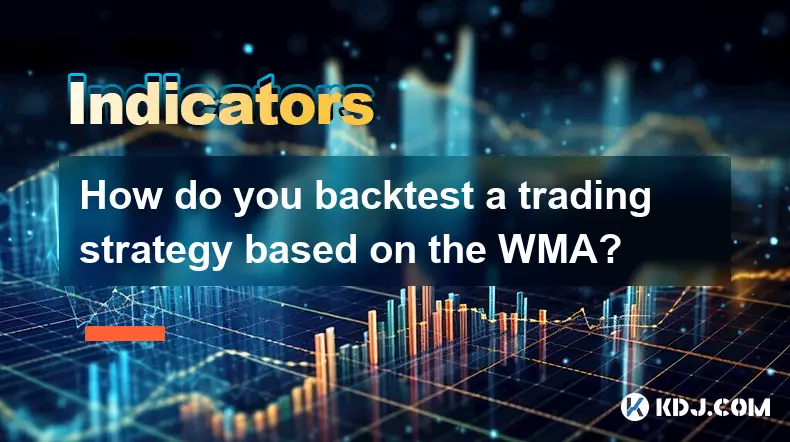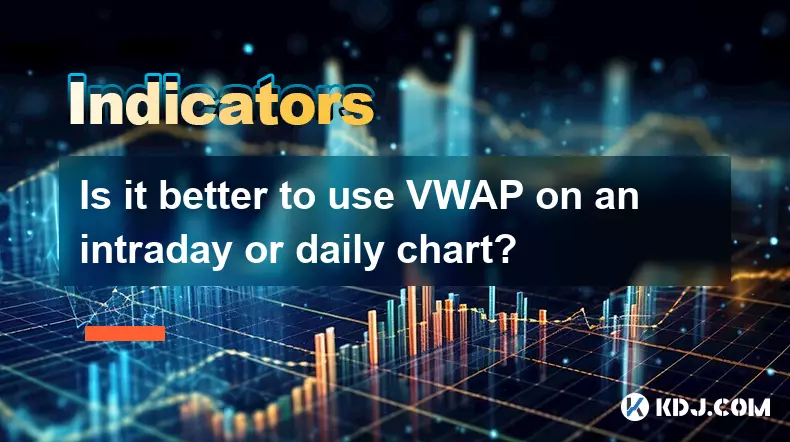-
 bitcoin
bitcoin $108842.957301 USD
-1.88% -
 ethereum
ethereum $3931.777121 USD
-1.66% -
 tether
tether $1.000186 USD
-0.03% -
 bnb
bnb $1153.250882 USD
-2.20% -
 xrp
xrp $2.367904 USD
-1.94% -
 solana
solana $186.182050 USD
-4.20% -
 usd-coin
usd-coin $0.999997 USD
0.00% -
 tron
tron $0.316949 USD
-1.00% -
 dogecoin
dogecoin $0.190780 USD
-3.12% -
 cardano
cardano $0.651324 USD
-2.67% -
 hyperliquid
hyperliquid $37.141055 USD
-0.85% -
 ethena-usde
ethena-usde $0.999224 USD
-0.09% -
 chainlink
chainlink $17.579031 USD
-2.47% -
 bitcoin-cash
bitcoin-cash $509.426284 USD
-2.79% -
 stellar
stellar $0.315298 USD
-2.93%
How do you backtest a trading strategy based on the WMA?
The Weighted Moving Average (WMA) enhances trend detection in crypto trading by prioritizing recent prices, offering quicker responses to volatility and improving signal accuracy when combined with volume or oscillators.
Oct 15, 2025 at 04:54 pm

Understanding the Weighted Moving Average (WMA) in Trading
1. The Weighted Moving Average assigns greater importance to recent price data, making it more responsive to new information compared to simple moving averages. This sensitivity allows traders to detect trend changes earlier, which is crucial in fast-moving crypto markets. Because of its design, WMA reacts faster to volatility spikes common in digital asset pricing.
2. In the context of cryptocurrency trading, where price swings can be extreme and sudden, using WMA helps filter out noise while still capturing momentum shifts. Traders often combine WMA with volume data or other oscillators to confirm signals. Its mathematical formula emphasizes recency, giving linearly decreasing weights to older prices within the lookback period.
3. When constructing a strategy around WMA, defining the time frame—such as 10-period or 20-period—is essential. Shorter periods increase sensitivity but may lead to false signals; longer periods smooth results but lag behind price action. Backtesting must account for these trade-offs across various market conditions including bull runs, bear phases, and sideways consolidation.
Data Collection and Preparation for Accurate Backtesting
1. High-quality historical price data is foundational for reliable backtesting. For WMA-based strategies, minute-by-minute or hourly candlestick data from major exchanges like Binance or Coinbase should be used. Ensure the dataset includes open, high, low, close, and volume for each interval to support robust signal generation.
2. Clean the data by removing anomalies such as duplicated timestamps, missing candles, or erroneous spikes caused by exchange glitches. Crypto markets operate 24/7, so timezone alignment isn’t an issue, but consistency in sampling frequency is critical. Irregular intervals can distort WMA calculations and invalidate test outcomes.
3. Adjust for splits or token swaps if testing over long durations. While traditional stocks have corporate actions, cryptocurrencies may undergo hard forks or rebranding that affect price continuity. Ignoring these events introduces bias into performance metrics like drawdowns and win rates.
Implementing and Evaluating the WMA Strategy
1. Define clear entry and exit rules based on WMA crossovers or slope direction. For example, a buy signal could trigger when the price crosses above the 10-period WMA and the WMA line turns upward. Exit conditions might include crossing below the WMA or hitting a predefined profit target or stop-loss level.
2. Use programming environments like Python with libraries such as Pandas and NumPy to calculate WMA values efficiently. Vectorized operations allow rapid computation across thousands of data points. Integrate transaction costs and slippage assumptions reflective of real trading on decentralized or centralized platforms.
3. Measure performance using key indicators: total return, Sharpe ratio, maximum drawdown, win rate, and average gain per trade. Compare results against a benchmark, such as holding BTC or ETH over the same period. A successful WMA strategy should demonstrate consistent edge across multiple assets and timeframes.
4. Run walk-forward analysis to validate robustness. Divide historical data into training and testing segments, optimize parameters on the former, then evaluate on the latter. Repeat this process incrementally to simulate how the strategy would perform in live deployment without overfitting.
Risks and Limitations of WMA-Based Approaches
1. Over-optimization remains a major pitfall. Tuning WMA periods too precisely to past data may yield excellent backtest results but fail in live markets. Strategies that work well during high-volatility regimes may underperform in stable conditions, leading to inconsistent returns.
2. Market regime shifts can render WMA signals ineffective, especially during news-driven events or macroeconomic shocks affecting the entire crypto sector. Algorithmic strategies relying solely on technical patterns struggle when structural breaks occur, such as regulatory announcements or exchange collapses.
3. Liquidity constraints are often overlooked in backtests. Large orders based on WMA signals may move the market in low-volume altcoins, resulting in poor execution prices not reflected in historical data. Simulated trades assume full fill at listed prices, which diverges from reality during flash crashes or pump-and-dump schemes.
4. Repainting risks exist if lookahead bias is introduced, either through incorrect timestamp alignment or using future data in WMA calculation. Even minor errors here can inflate profitability artificially, leading to dangerous confidence in flawed systems.
Frequently Asked Questions
What is the difference between WMA and EMA in crypto trading?WMA applies linearly decreasing weights to past prices within a fixed window, while EMA uses exponential smoothing with infinite memory. EMA reacts faster to recent price changes and is more commonly used in algorithmic systems due to its recursive nature, requiring less storage.
Can WMA be combined with RSI for better signals?Yes, combining WMA with RSI helps distinguish between trend strength and overbought/oversold conditions. For instance, entering long only when price is above WMA and RSI is below 30 can reduce false entries during strong downtrends.
How do I avoid curve-fitting when optimizing WMA periods?Test a range of WMA lengths rather than selecting one that maximizes returns on a single dataset. Use out-of-sample validation and assess performance across diverse market cycles. Prioritize stability of results over peak profitability.
Is WMA suitable for scalping in volatile cryptocurrencies?WMA can be effective for scalping due to its responsiveness, particularly on short timeframes like 5-minute charts. However, frequent signals increase exposure to transaction fees and require tight risk controls to remain profitable after costs.
Disclaimer:info@kdj.com
The information provided is not trading advice. kdj.com does not assume any responsibility for any investments made based on the information provided in this article. Cryptocurrencies are highly volatile and it is highly recommended that you invest with caution after thorough research!
If you believe that the content used on this website infringes your copyright, please contact us immediately (info@kdj.com) and we will delete it promptly.
- ICO Revival: Structured Investment vs. Speculative Frenzy in 2025
- 2025-10-17 16:25:17
- Ripple Labs, XRP, and $1 Billion: A Bold Bet on the Future of Digital Asset Treasuries
- 2025-10-17 16:25:17
- Dogecoin, Musk, and Price Predictions: A NYC Perspective
- 2025-10-17 17:05:16
- Bitcoin, Gold, and the Rally Race: Will BTC Shame Gold's Shine?
- 2025-10-17 16:45:14
- Dai Stablecoin: Navigating Crypto Turmoil and Maintaining the $1 Peg
- 2025-10-17 17:05:16
- COAI Price Soaring: Profit or Just a Mirage?
- 2025-10-17 16:30:01
Related knowledge

What's the main difference between VWAP and TWAP?
Oct 12,2025 at 11:54am
Understanding VWAP and Its Role in Crypto Trading1. Volume Weighted Average Price (VWAP) is a trading benchmark that calculates the average price of a...

How do you identify exhaustion moves using VWAP and its bands?
Oct 12,2025 at 08:00am
Understanding the Role of Decentralized Exchanges in Crypto Trading1. Decentralized exchanges (DEXs) operate without a central authority, allowing use...

Is it better to use VWAP on an intraday or daily chart?
Oct 15,2025 at 02:01am
Intraday Trading and the Role of VWAP1. Intraday traders frequently rely on VWAP (Volume Weighted Average Price) as a dynamic benchmark for assessing ...

How do you use VWAP to scale in and out of positions?
Oct 14,2025 at 02:19am
Understanding VWAP as a Dynamic Benchmark1. The Volume Weighted Average Price (VWAP) is not just an indicator—it functions as a dynamic benchmark that...

What are the main advantages of using VWAP over EMA?
Oct 11,2025 at 02:18am
Main Advantages of Using VWAP Over EMA1. Volume-Weighted Average Price (VWAP) incorporates trading volume into its calculation, offering a more accura...

How do you use VWAP on different chart types like Heikin Ashi?
Oct 11,2025 at 05:01pm
Understanding VWAP in the Context of Heikin Ashi Charts1. The Volume Weighted Average Price (VWAP) is a powerful analytical tool commonly used by trad...

What's the main difference between VWAP and TWAP?
Oct 12,2025 at 11:54am
Understanding VWAP and Its Role in Crypto Trading1. Volume Weighted Average Price (VWAP) is a trading benchmark that calculates the average price of a...

How do you identify exhaustion moves using VWAP and its bands?
Oct 12,2025 at 08:00am
Understanding the Role of Decentralized Exchanges in Crypto Trading1. Decentralized exchanges (DEXs) operate without a central authority, allowing use...

Is it better to use VWAP on an intraday or daily chart?
Oct 15,2025 at 02:01am
Intraday Trading and the Role of VWAP1. Intraday traders frequently rely on VWAP (Volume Weighted Average Price) as a dynamic benchmark for assessing ...

How do you use VWAP to scale in and out of positions?
Oct 14,2025 at 02:19am
Understanding VWAP as a Dynamic Benchmark1. The Volume Weighted Average Price (VWAP) is not just an indicator—it functions as a dynamic benchmark that...

What are the main advantages of using VWAP over EMA?
Oct 11,2025 at 02:18am
Main Advantages of Using VWAP Over EMA1. Volume-Weighted Average Price (VWAP) incorporates trading volume into its calculation, offering a more accura...

How do you use VWAP on different chart types like Heikin Ashi?
Oct 11,2025 at 05:01pm
Understanding VWAP in the Context of Heikin Ashi Charts1. The Volume Weighted Average Price (VWAP) is a powerful analytical tool commonly used by trad...
See all articles










































































